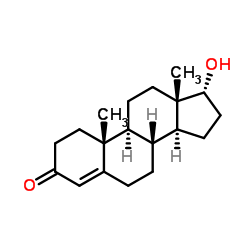Epitestosterone

Epitestosterone structure
|
Common Name | Epitestosterone | ||
|---|---|---|---|---|
| CAS Number | 481-30-1 | Molecular Weight | 288.424 | |
| Density | 1.1±0.1 g/cm3 | Boiling Point | 432.9±45.0 °C at 760 mmHg | |
| Molecular Formula | C19H28O2 | Melting Point | 218-220ºC | |
| MSDS | N/A | Flash Point | 184.7±21.3 °C | |
| Symbol |


GHS02, GHS07 |
Signal Word | Danger | |
|
Analysis of anabolic androgenic steroids in urine by full-capillary sample injection combined with a sweeping CE stacking method.
Anal. Bioanal. Chem 405(6) , 1969-76, (2013) This study describes an on-line stacking CE approach by sweeping with whole capillary sample filling for analyzing five anabolic androgenic steroids in urine samples. The five anabolic steroids for detection were androstenedione, testosterone, epitestosterone... |
|
|
Relevance of the selective oestrogen receptor modulators tamoxifen, toremifene and clomiphene in doping field: endogenous steroids urinary profile after multiple oral doses.
Steroids 76(12) , 1400-6, (2011) The present study was performed to investigate the influence of the intake of selective oestrogen receptor modulators on the urinary endogenous steroids profile. For this purpose the circadian variability of luteinizing hormone, follicle-stimulating hormone, ... |
|
|
UDP-glucuronosyltransferase 2B17 genotyping in Japanese athletes and evaluation of the current sports drug testing for detecting testosterone misuse.
Drug Test. Anal. 5(3) , 166-81, (2013) Ethnicity has been found to influence urinary testosterone glucuronide to epitestosterone glucuronide (T/E) ratios among athletes. Uridine diphospho-glucuronosyltransferase 2B17 (UGT2B17) is the most active enzyme in testosterone glucuronidation. UGT2B17 poly... |
|
|
Epitestosterone.
J. Steroid Biochem. Mol. Biol. 87(1) , 27-34, (2003) Epitestosterone has been identified as a natural component of biological fluids of several mammals including man. For a long time it was believed that it is a metabolite without any hormonal activity and without any marked relationship to the hormonal state i... |
|
|
Optimization of LC method for the determination of testosterone and epitestosterone in urine samples in view of biomedical studies and anti-doping research studies.
Talanta 83(3) , 804-14, (2011) A sensitive and rapid liquid chromatographic (LC) method for the simultaneous determination of testosterone (T) and epitestosterone (E) in human urine samples has been developed and elaborated. The ratio of the both steroids (T/E) in human urine is a widely u... |
|
|
Detection of testosterone and epitestosterone in human hair using liquid chromatography-tandem mass spectrometry.
J. Pharm. Biomed. Anal. 67-68 , 154-8, (2012) The feasibility of using hair analysis as a complimentary test in doping control has received increased attention in the scientific community. The aim of the study was to take a step forward to this goal and develop a method that, for the first time, is able ... |
|
|
Epidemiological investigation of the UGT2B17 polymorphism in doping control urine samples and its correlation to T/E ratios.
Drug Test. Anal. 3(10) , 645-51, (2011) The deletion polymorphism of the enzyme UGT2B17 is known to correlate with the level of the testosterone to epitestosterone (T/E) ratio in urine specimen. Due to the importance of the T/E ratio to detect testosterone abuse in doping analysis, a PCR-ELISA syst... |
|
|
In vitro metabolic studies using homogenized horse liver in place of horse liver microsomes.
Drug Test. Anal. 3(6) , 393-9, (2011) The study of the metabolism of drugs, in particular steroids, by both in vitro and in vivo methods has been carried out in the authors' laboratory for many years. For in vitro metabolic studies, the microsomal fraction isolated from horse liver is often used.... |
|
|
Use of hydrogen as a carrier gas for the analysis of steroids with anabolic activity by gas chromatography-mass spectrometry.
J. Chromatogr. A. 1218(41) , 7365-70, (2011) Due to the impact in the media and the requirements of sensitivity and robustness, the detection of the misuse of forbidden substances in sports is a really challenging area for analytical chemistry, where any study focused on enhancing the performance of the... |
|
|
A molecularly imprinted receptor for separation of testosterone and epitestosterone, based on a steroidal cross-linker.
Steroids 76(5) , 478-83, (2011) A series of molecularly imprinted polymers have been prepared and investigated as stationary phases in high performance liquid chromatography for the separation of testosterone and epitestosterone using non-polar mobile phases. The polymers were imprinted usi... |